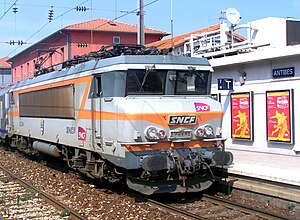SNCF Class BB 22200
| SNCF Class BB 22200 | |||||||||||||||||||||||
|---|---|---|---|---|---|---|---|---|---|---|---|---|---|---|---|---|---|---|---|---|---|---|---|
 22394 at Antibes station (2006) | |||||||||||||||||||||||
| |||||||||||||||||||||||
| |||||||||||||||||||||||
| |||||||||||||||||||||||
| |||||||||||||||||||||||
The BB 22200 is a class of electric locomotives in service with the French railways SNCF, built by Alstom between 1976 and 1986. They are a dual voltage version (1500 V DC and 25 kV 50 Hz AC) of the BB 7200 and BB 15000 classes.[note 1]
From 1994 nine of the class were used for hauling freight trains through the Channel Tunnel as the Class 92 locomotives were not yet delivered.[1][2] These were numbered 22379/380/399-405,[3] and were used until 1995.[citation needed] For use on British railways these locomotives were allocated the UK traction number Class 22.[4]
History, operations and design
After the first test held in 1976, the BB 22200 were introduced on the Marseille–Nice–Ventimiglia line in southern France–northern Italy. The following year they started to haul longer distance trains such as the Train Bleu (1000 km from Ventimiglia to Paris) and the car-transport train between Marseille and Paris.
The BB 22200 are capable of a maximum speed of 160 kilometres per hour (99.4 mph). 8 locomotives, having a maximum power of 5,600 kilowatts (7,500 hp), were equipped for services up to 200 kilometres per hour (124 mph) and can work on TGV lines.

See also
- SNCF BB 20011 and 20012 two locomotives of the class used as test locomotives for synchronous electric motors and other technology used in the SNCF Class BB 26000
Notes
- ^ The designation "22000" is in fact the sum of 7200 and 15000
References
- ^ Colin J. Kirkland (1995). Engineering the Channel Tunnel. Taylor & Francis. p. 297.
- ^ Annual report 1989-90. Channel Tunnel Safety Authority. 1991. pp. 16, 111.
- ^ Haydock, David; Fox, Peter (1999). European Handbook No.4 French Railway Locomotives & Multiple Units. Platform 5, Sheffield. ISBN 1-872524-87-7.
- ^ TheRailwayCentre.Com. "The all-time guide to the UK Traction Classification System" (PDF). Retrieved 2008-01-13.
